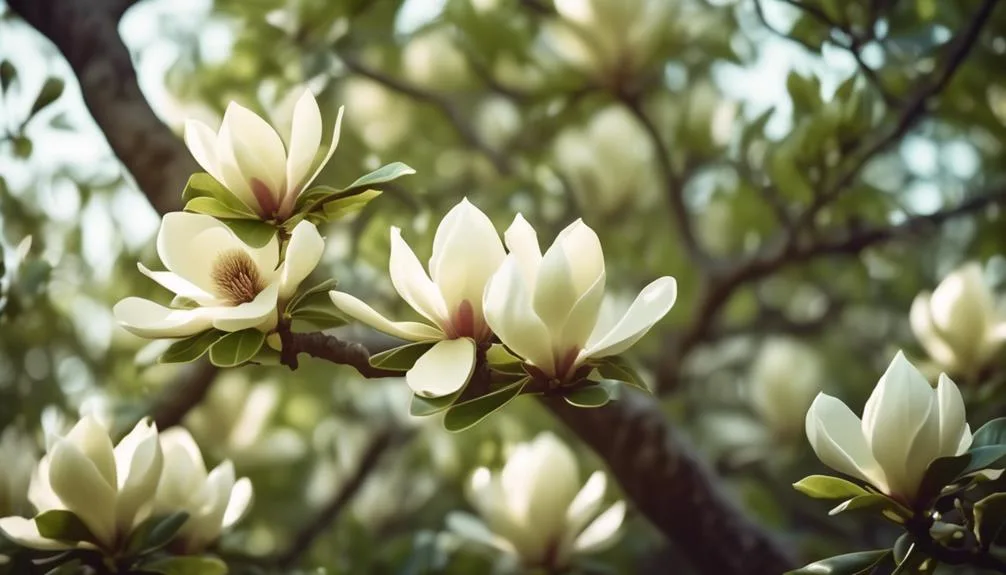Are Magnolia Trees Resistant to Pests and Diseases
Picture a peaceful garden with a beautiful magnolia tree, known for its resilience. But how well do they actually fend off pests and diseases? Exploring magnolia tree care reveals surprising truths about their defenses and vulnerabilities.
Gain insights into maintaining the health and vitality of these beloved botanical beauties.
Natural Resistance to Pests
When caring for your magnolia trees, understanding their natural resistance to pests can help you maintain their health and beauty without excessive intervention.
Magnolia trees have developed strong natural defenses against pests, making them relatively low-maintenance in terms of pest control. The trees produce natural compounds that act as insect deterrents, deterring many common pests from infesting them. Additionally, their waxy leaves and sturdy bark provide a physical barrier against pests.
This pest resistance means that you won't need to rely heavily on chemical pesticides to keep your magnolia trees healthy. By simply providing proper care and maintenance, such as regular watering and pruning, you can support your magnolia's natural pest resistance and enjoy their beauty without the worry of pests causing significant damage.
Vulnerability to Common Diseases
You should be aware that while magnolia trees have natural defenses against pests, they're vulnerable to certain common diseases that can impact their health and appearance. Two significant threats to magnolia trees are fungal infections and insect infestations.
- Fungal Infections
- Magnolia trees are susceptible to fungal diseases such as powdery mildew and anthracnose, which can lead to leaf discoloration, defoliation, and overall decline in the tree's health.
- Proper air circulation and avoiding overhead watering can help prevent the onset of fungal infections in magnolia trees.
- Insect Infestations
- Magnolia trees can be targeted by various insect pests, including scale insects and magnolia scale, which can cause leaf yellowing, premature leaf drop, and a decline in tree vigor.
- Regular inspection for early detection and appropriate insecticidal treatments can help manage insect infestations effectively.
Common Pests Affecting Magnolia Trees
Magnolia trees are commonly affected by a variety of pests that can threaten their health and vitality. One of the most common pests is the magnolia scale, which appears as small, white, waxy bumps on the branches. These pests can weaken the tree by sucking out its sap.
Another significant threat is the magnolia leaf miner, whose larvae tunnel through the leaves, causing them to turn brown and fall prematurely. To control these pests, regular inspection and early detection are crucial. Applying horticultural oils or insecticidal soaps can help manage infestations.
Additionally, maintaining tree health through proper watering, fertilization, and pruning can enhance its natural defenses against pests. By staying vigilant and implementing effective pest control measures, you can prevent infestations and protect the beauty of your magnolia trees.
Disease Management and Prevention
Managing and preventing diseases in magnolia trees is essential for maintaining their health and beauty. Controlling pests is also crucial for their well-being. To effectively manage diseases in magnolia trees, it's important to implement integrated pest and disease management strategies. This involves utilizing a combination of cultural practices and prevention strategies to minimize the risk of diseases.
Here are some key points to consider:
- Cultural Practices
- Regularly prune and remove dead or diseased branches to promote air circulation and reduce the risk of fungal infections.
- Ensure proper spacing between trees to prevent overcrowding, which can lead to increased humidity and disease susceptibility.
Tips for Maintaining Tree Health
To maintain the health of your magnolia trees, it's essential to implement regular care and maintenance practices that promote their overall well-being and resilience against pests and diseases.
Proper pruning techniques play a crucial role in maintaining tree health. Regularly prune dead or diseased branches to prevent the spread of infections and promote new growth. Additionally, pruning can help improve air circulation within the tree, reducing the risk of fungal diseases.
When it comes to soil nutrition, ensuring that your magnolia tree receives adequate nutrients is vital. Consider using organic mulch to enrich the soil and provide essential nutrients. Conduct soil tests to identify any deficiencies and adjust fertilizer applications accordingly.
Conclusion
Magnolia trees exhibit resistance to many pests. However, they are susceptible to common diseases like leaf spot and powdery mildew.
Regular inspection and proper care are essential to maintain the health of magnolia trees. By nurturing your magnolia tree, you can ensure its longevity and enduring beauty.

My interest in trees started when I first saw the giant sequoias in Yosemite.
I was a teenager then, and I remember thinking, “I need to learn more about this.”
That moment stuck with me.
A few years later, I went on to study forestry at Michigan Tech.
Since graduating, I’ve worked in a mix of hands-on tree care and community education.
I’ve spent over ten years helping people understand how to plant, maintain, and protect the trees in their neighborhoods.
I don’t see trees as just part of the landscape.
They are living things that make a real difference in our daily lives.
